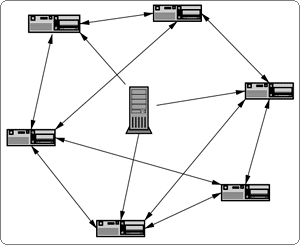
It's been 10 years since Bram Cohen, Chief Scientist and Co-founder of BitTorrent, Inc. first invented the revolutionary peer-to-peer (P2P) file-sharing protocol for transferring large files over the Internet. Now on its 10 year anniversary, BitTorrent's disruptive technology has an installed base of over 160 million clients worldwide, and has grown to become a viable distribution platform for content producers around the world. The company, which first incorporated in 2004 has shifted its focus back to its roots in content delivery, and looks to seeding its future in live streaming.
While the P2P file-sharing protocol has long been associated with digital piracy, BitTorrent has worked with a variety of filmmakers, musicians and authors over the past year, to help distribute films using the company’s P2P technology.
I caught up with Cohen at last year's NewTeeVee Live where he discussed BiTorrent's future in P2P live streaming. In an interview with TorrentFreak, Cohen said that solving a challenging technical problem while creating value was his motivation to get started on a P2P live streaming solution.
“I am fundamentally a technologist, and am simply not interested in working on something which doesn’t solve the fundamental problem it’s supposed to tackle, especially in a market where there have already been so many bad technologies which failed to succeed based on sales and marketing,” he said. (Source: Bram Cohen To Deliver BitTorrent Live Streaming | TorrentFreak)
 |
| Source: BitTorrent.org » For Users |
Cohen has been working on his P2P live streaming protocol over the past few years and admits it's been challenging. Low latency is the biggest issue, as he points out that data is being handed across several peers along the way.
"BitTorrent is peer-to-peer file distribution. Live streaming is a very difficult and challenging and rewarding problem, because there are a few things you have to get it work all at once." he said. " You have to get offloads to as close as 100% as possible. They should be at least 99% if you've got a million people watching something. You want get it very robust, so it doesn't fail horribly; and, you want to get the latency between when the video is taken to when it is displayed on everyone's machines as low as possible and I'm shooting for around 5 seconds."Cohen says he has some very unorthodox techniques he's come up with to deal with these issues and plans to roll it out anyway now. (Ed. note: I spoke with in November 2010 and he estimated the roll out within eight months timeframe.)
BitTorrent's two main software products, the Mainline client and flagship uTorrent, have amassed a huge user base and the company has been shifting it's resources to developing clients to reach that audience. Cohen says right now the company is working on their engagement with our existing user base and trying to get others to reach them. They are also working with device manufacturers to make software run on their devices to help with file distribution.
About BitTorrent
BitTorrent creates advanced, innovative technologies to efficiently move large files across the Internet. The company's two main products today include the original BitTorrent software and the tiny-but-mighty µTorrent, which combined boast over 100+ million users. BitTorrent is based in San Francisco, Calif. For more information, visit www.bittorrent.com, and follow on Twitter, or Facebook.
Related:
- Bram Cohen on the Future of BitTorrent — Online Video News
- Bram Cohen: BitTorrent Protocol & Live Streaming Don’t Mix — Online Video News
- BitTorrent Inventor Bram Cohen On BitTorrent’s Future | TorrentFreak
- Bram Cohen To Deliver BitTorrent Live Streaming | TorrentFreak
- Live Streaming in the Works at BitTorrent - Streaming Media Magazine
- BitTorrent's P2P Live Streaming: A Video First Look - Streaming Media Magazine
- CES: BitTorrent plans torrenting ecosystem, hardware partnerships - CES 2011 CNET Blogs